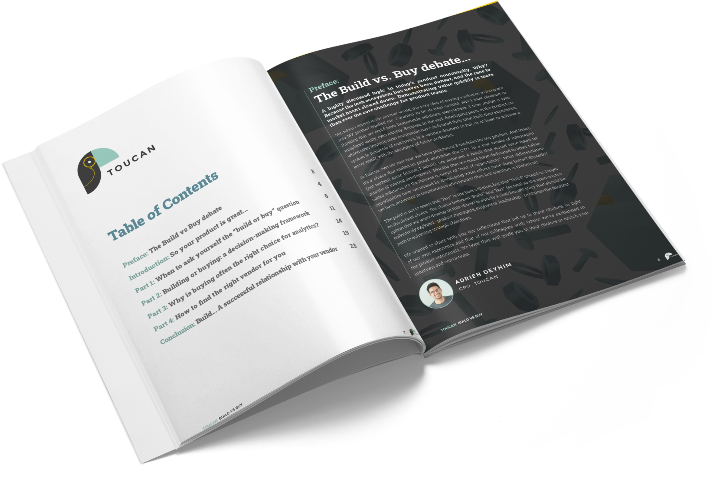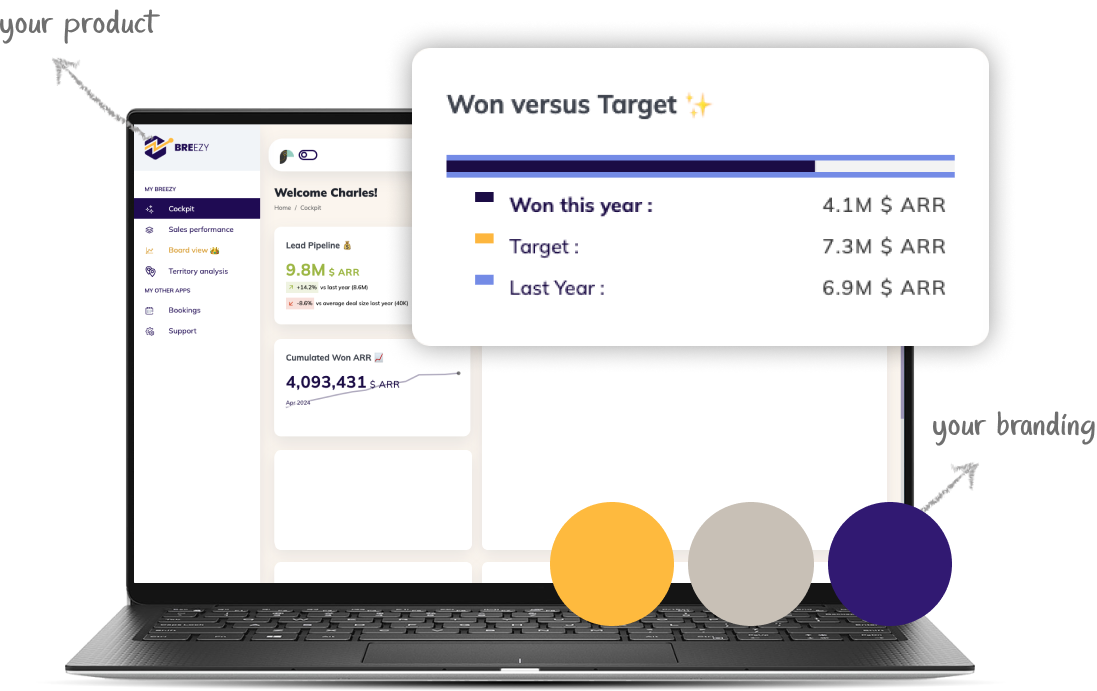Imagine you’re running a successful SaaS company, offering powerful tools that help businesses streamline their operations. Your clients depend on you for actionable insights.
Now, consider another scenario: you’re managing a digital marketing agency with multiple clients, each requiring customized data reports.
In both cases, your clients expect polished, professional dashboards that highlight their key performance indicators (KPIs). Building these data visualizations from the ground up, however, is a major time drain.
This is where white-label dashboards come in. By tapping into third-party reporting solutions, you can easily integrate advanced analytics into your platform or client presentations, all while maintaining a consistent brand experience.
What is white label reporting?
White label reporting enables companies to deliver professional, visually appealing data visualization that aligns with their branding guidelines. These dashboards provide users with a centralized view of their data, enabling them to monitor KPIs, identify trends, and make data-driven decisions.
Solutions on the market often include customizable templates and drag-and-drop interfaces, allowing agencies to create reports efficiently without extensive design skills. These platforms typically integrate with various data sources, such as Google Analytics, social media platforms, and CRM systems, to aggregate data automatically. This automation reduces manual data entry and minimizes errors!
By delivering these reports through branded email communications or client portals, you can keep clients informed and engaged, fostering trust and long-term partnerships.
To better understand, note that the popularity of white label reporting has surged in recent years, driven by several key factors.
- The exponential growth of data has made it imperative for agencies to provide their clients with meaningful insights and actionable intelligence. But there’s more.
- The increasing complexity of data analysis has made it challenging for agencies to develop and maintain their own reporting solutions.
- The increasing objective of removing the need for separate reporting tools, instead integrating reporting directly into the platforms where people already work daily.
White-label reporting addresses these challenges by providing a turnkey solution that can be quickly deployed and customized to meet specific client needs.
Main white-label reporting advantages
Brand consistency and recognition
One of the primary benefits of white-label data visualization is the ability to maintain brand consistency across all customer touchpoints. By integrating a white-label solution into your existing platform, you can ensure that your clients experience a uniform brand identity throughout their interaction with your services. This consistency reinforces brand recognition and builds trust, as customers associate the powerful data visualization capabilities with your company's name and reputation.
Customization and branding: the cornerstone of white label reporting
Customization goes beyond mere aesthetics. It enhances client communication and strengthens the agency-client relationship. By incorporating client logos, color schemes, and custom cover pages, agencies can create reports that resonate with their clients and reinforce their brand identity. This level of customization ensures that your clients perceive the data visualization tools as an integral part of your service offering, rather than a disparate third-party solution.
Predictive analysis and informed decision-making
White label BI tools offer advanced predictive analytics capabilities, utilizing machine learning algorithms. These models can be applied to various marketing metrics like campaign ROI, conversion rates, or customer lifetime value.
For example, you can use time series analysis to forecast organic traffic or classification models to segment your audience. These predictions, visualized through interactive graphs (scatter plots, heat maps, etc.), allow you to justify your strategies with concrete data and optimize marketing budget allocation.
Time and cost efficiency
Developing a robust data visualization platform from scratch requires significant time, resources, and expertise. By opting for a white label solution, you can bypass the lengthy development process and benefit from a ready-to-use platform that has been tested and refined. This approach saves valuable time and resources, allowing you to focus on your core business operations while still providing cutting-edge data visualization capabilities to your clients. Additionally, white label solutions often come with a predictable pricing model, enabling you to manage costs effectively.
New revenue opportunities
White label reporting paves the way for value-based differential pricing. You can offer basic reports included in your standard services, then charge for more advanced analyses or premium dashboards as additional services (predictive analytics, custom alerts, data-driven consulting, etc.).
Consider also offering dashboard usage training, data interpretation workshops, or data audits to identify new optimization opportunities. By using techniques like A/B testing on your reporting offers, you can optimize your pricing strategy and maximize your revenue while providing increasing added value to your clients.
4 Key features of white label data visualization platforms
When choosing a white label data visualization platform, it's essential to consider the key features that will empower your brand and deliver value to your clients. Look for the following capabilities.
Intuitive user interface
A user-friendly interface is crucial for ensuring that your clients can easily navigate and interact with the data visualization tools. The platform should offer an intuitive drag-and-drop interface that allows users to create and customize dashboards quickly. It should also provide a range of pre-built templates and widgets to streamline the dashboard creation process, as well as custom email domains for sending reports, and custom dashboard domains for hosting branded client dashboards. A good way for users to generate meaningful insights with minimal effort!
Flexibility in color schemes
Color plays a significant role in brand identity, and white label reporting should offer flexibility in incorporating brand colors. This includes applying brand colors to headings, subheadings, and body text, creating a cohesive visual experience. This also implies the ability to modify background colors, chart elements, and headers, ensuring alignment with the overall brand aesthetic.
Advanced data connectors
To maximize the value of your white label data visualization platform, it should seamlessly integrate with a wide range of data sources. Look for a solution that offers advanced data connectors, allowing your clients to pull data from various databases, cloud storage services, and business applications. The ability to connect to diverse data sources ensures that your clients can create comprehensive dashboards that provide a holistic view of their business performance.
Robust security and privacy
Data security and privacy are paramount concerns for any business. When selecting a white label data visualization platform, ensure that it adheres to stringent security standards and complies with relevant data protection regulations. The platform should implement robust access controls, data encryption, and regular security audits to safeguard your clients' sensitive information. Additionally, look for features like user role management and single sign-on (SSO) integration to streamline access control and enhance overall security.
Start white label dashboards project in 3 steps
Incorporating a white label data visualization platform into your business involves careful planning and execution. Here are some key steps to ensure a successful implementation.
Assess your business needs
Consider factors such as the types of data sources you need to integrate, the level of customization required, and the scalability of the platform to accommodate future growth. Clearly defining your requirements will help you choose a white label solution that aligns with your business objectives.
Evaluate platform capabilities
Conduct a comprehensive evaluation of potential white label data visualization platforms to ensure they meet your identified requirements. Assess the platform's user interface, data connectivity options, customization capabilities, and security features. Additionally, consider the level of support and documentation provided by the platform vendor, as this can greatly impact the success of your implementation and ongoing usage.
Develop a roadmap
Once you have selected a white label data visualization platform, develop a roadmap for implementation. Identify key milestones, such as platform customization, data integration, user training, and launch. Assign responsibilities to team members and establish a timeline for each phase of the implementation process. Regular communication and collaboration among stakeholders are essential to ensure a smooth and successful rollout.
What to expect about white label reporting in the future?
The rise of artificial intelligence and machine learning will further enhance the capabilities of white label reporting tools. These advanced technologies will enable agencies to deliver predictive insights, automate anomaly detection, and provide personalized recommendations to their clients. By staying at the forefront of these technological advancements, agencies can differentiate themselves and provide unparalleled value to their clients.






